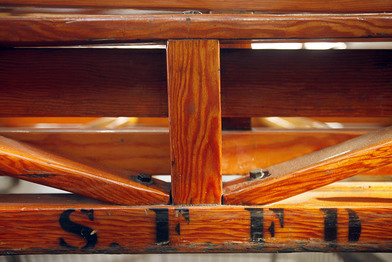
Are you aware that the San Francisco Fire Department still use the wood ladders in the fire service. I could not agree witht them more. The Rails (sides) of the ladders were made of Ashwood, a very flexiable but strong closed fiber wood. The rounds were made of Oak a very tough close grain wood that withstood whare. The most important factor was that they were not subject to becoming a conductor of electricity. In the old cities powerlines used to drap from eave to eave all the way down the block. Many pole lines are very close to the front of buildings and again the exposre is great for any firefighter using metal ladders.
A wood ladder is easier to inspect for safety problems and repairs or replacements can be made. True they are very heavy to handle. It takes eight men to carry, step, raise, and place a 55 foot Bangor Ladder in place and it can be used in a Steeple Raise (straight up) or leaned against a four story building. Eight men you say Chief? Yes, two at the foot to ground it, two at the head to lift it, and two each on the Tormentor Poles to help raise the head and at the same time stabilize the ladder. Tormentor poles are attached to the head of the rails of the ground section of the ladder with gimbels that alow the firefighters to stabilize the ladder at 90 degree angles. Once the ladder is raised straight up the crew at the bottom becomes four and they will in turn raise the fly section of the ladder to the required height on the building. It does take a lot of training and drilling and this today is at a loss. The man power shortage hurts the use of ground ladders and certainly it is to easy to use arial ladders and platforms and as such I have witnessed where areas of a buildings that should have been covered by ladders that were not and the fire continued unabated, the fire being driven from the front of the building chased all the way to the back. Another note, metal ladders get iced up much quicker than wood ladders in the northern latitudes, that in itself is pretty tricky.
God's speed, Frank

My grammar school (Highland Avenue) was right across the street from the firehouse in Lansdowne Pennsylvania and every time the fire whistle sounded got my attention then when I was in 9th grade the Korean War tapped into our volunteer fire company so badly that the town fathers looked toward high school kids to take up the slack. Mr. Albert Baccini who was Manager of Fire and Safety at Atlantic Refinery took on us Freshman through Seniors and we spent Fridays learning Civil Defense and CD Auxiliary Firefighter. Come June, six of us were introduced to the Fire Chief. I never quit but I retired 60 years later.
 RSS Feed
RSS Feed
